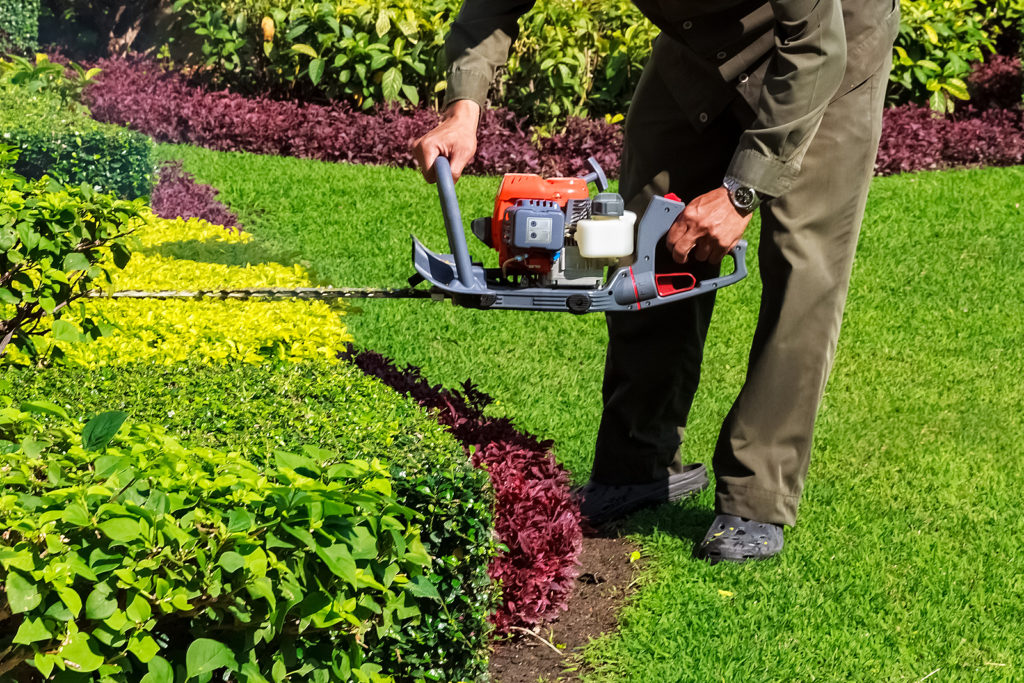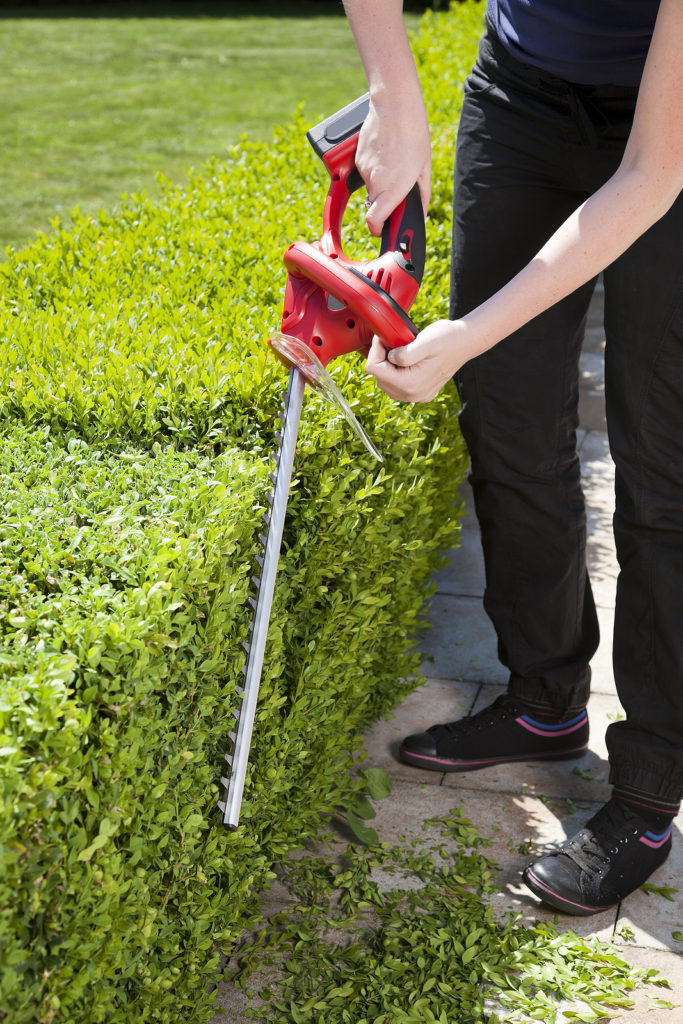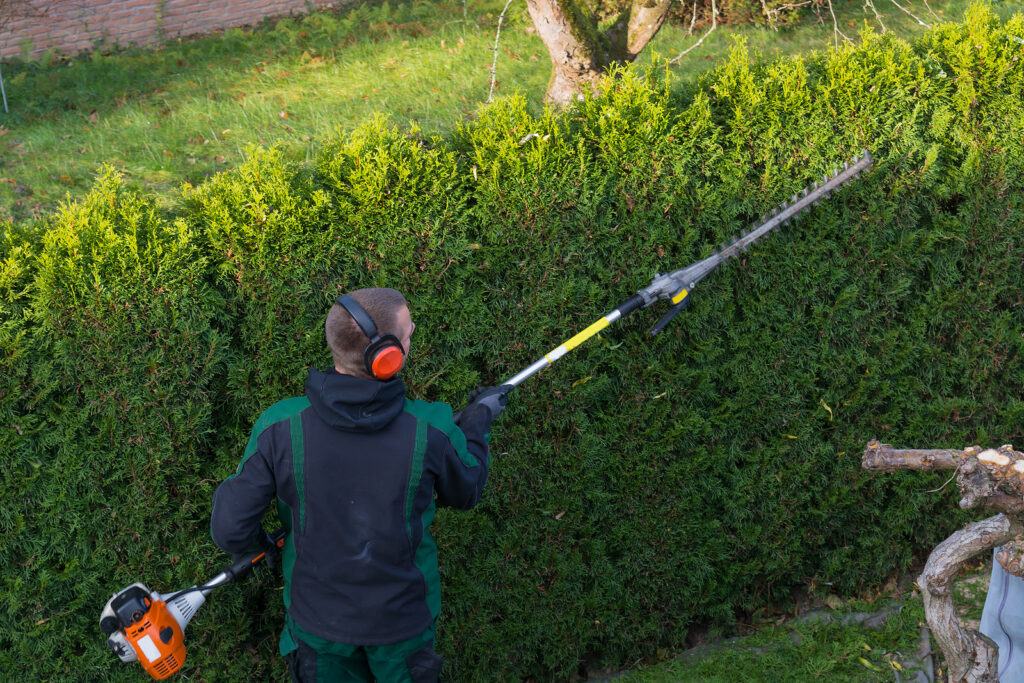A power hedge trimmer is a great gardening tool. A power hedge trimmer can help you keep your hedges looking neat and tidy. It also can be used for a variety of other tasks, such as cutting tall grass and weeds, trimming bushes, and even pruning small trees. A power hedge trimmer is a versatile tool that can make yard work much easier.
Hedge trimmers come in a variety of shapes and sizes, and can be electric (battery or corded) or gas-powered. Choosing the right hedge trimmer for your needs can be a daunting task. With all of the different options on the market, how can you be sure you’re picking the right one?
Answering just a couple of questions will help you narrow down the possibilities. Firstly, what type of plants will you be cutting–small hedges or shrubs or large hedges, large shrubs, and small trees? The size of the material you will be cutting will help you determine the cutting capacity and engine that you will need. Secondly, where are the hedges and shrubs located? In a small yard close to the house near electrical outlets or in a large yard or field away from the house. An electric corded trimmer is well-suited for a small yard, a battery-powered trimmer is suited for a mid-size to large yard. and a gas-powered trimmer is best for a very large yard with lots of hedges and shrubs to trim.
So, what do you need to know to choose the best power hedge trimmer for your needs? Here’s our complete guide to help you make your decision.

What hedge trimmers are used for
- Power hedge trimmers are used to trim hedges, shrubs, and trees with branches about 1/4 inch to 1/2 thick; some professional models can cut branches up 1 inch thick.
- Hedge trimmers are not intended to cut thick tree limbs.
- When trimming a hedge, trim the top of the hedge so that it is narrower than the bottom; this allows sunlight to reach the bottom branches and the full surface of the hedge.
Hedge trimmer basics to know
- Hedger trimmers are also known as power shears, power hedge trimmers, and garden trimmers.
- A hedge trimmer has an electric or gasoline motor and a handle.
- Power hedge trimmer motors can be powered via an electric cord, rechargeable battery, or gasoline.
- Power hedge trimmers have one or two oscillating blades typically about 2 to 3 feet long; each blade has many large, pointed teeth. The blade or blades are called the cutting bar.
- Hedge trimmer blades sit on top of each other creating a gap between the offset teeth. As the blade or blades move back and forth, small branches fall into grooves along the bar and are cut as the gap closes.
- The blades of a power hedge trimmer can cut wood from one or both sides depending on the model.

Types of hedge trimmers
Electric corded hedge trimmers
Electric corded hedge trimmers run on electricity. Use is limited by the length of the cord. Corded hedge trimmers weigh about 6 to 10 pounds.
- Pros: usually the least expensive, lightest weight trimmer, starts instantly, runs indefinitely, least amount of vibration, no fuel, no need to recharge batteries, quieter than a gas model, no fumes, less maintenance.
- Cons: slower cutting speed, requires outlet and extension cord, range limited by the length of extension cord, potential electric shock, commonly suited for smaller hedges and yards–not large hedges.
- Tip: follow the device manufacturer’s instructions for selecting a compatible outdoor-rated extension cord (usually a 14-gauge or heavier 12-gauge extension). Extension cords usually max out at 100 feet.
- Cost: average $70 to $130.
Battery-powered cordless hedge trimmers
Cordless battery-powered hedge trimmers are powered by rechargeable batteries, commonly lithium-ion batteries. The batteries require a charging station that is plugged into an electrical outlet. Lithium-ion batteries provide the power and runtime to trim a hedge or shrubs in a small to mid-size residential yard. You will likely need a second battery so if the machine runs out of power while trimming you can finish the job.
Most battery trimmers use long-lasting lithium-ion batteries that can range from 20 to 80 volts. The battery life will depend on the weight of the trimmer, the age of the battery, and the amount and thickness of the material being cut.
- Pros: start instantly–no choke or pull-cord, good mobility, less vibration than gas models, the motor does not produce emissions; brushless motors and high-voltage batteries give long-lasting power, battery may be used with power equipment from the same manufacturer.
- Cons: cost can be about the same as gas trimmers, run time is determined by the voltage rating of the battery (about 30 to 60 minutes of semi-continuous cutting on a single charge), battery re-charge time of about 30 to 120 minutes can slow your work.
- Cost: $200 to $250; spare batteries can range from $40 to $125.
Gasoline-powered hedge trimmers
Gas hedge trimmers are the best choice for working in large yards, orchards, or fields where a long runtime is needed. Gas-powered trimmers are also powerful enough for cutting thicker branches. Gas trimmers are available with either 2-cycle or 4-cycle engines (4-stroke machines are heavy and professional grade). Two-cycle engines require a gas-oil mixture to run. Four-cycle engines run on regular gas (the oil is separate) and are the most powerful.
Gas-powered hedge trimmers have a gas tank capacity that ranges from 10 to 16 ounces. Most fuel tanks typically require a mixture of gas and oil at a ratio of 40:1 or 50:1; you can mix gas and oil yourself or purchase a pre-mixed fuel. Gas machines usually run from 45 minutes to 2 hours depending on the weight of the machine, the size of the engine, and the material being cut.
Gas trimmers weigh about 10 to 20 pounds depending on the size of the engine and the length of the cutting bar.
- Pros: best for heavier work, work anywhere. faster cutting, a big range of sizes, and cutting capacities to choose from.
- Cons: usually more expensive, needs fuel/oil mixtures, stepped starting procedure, heavier and noisier (use earplugs or ear-muff style headsets) than battery or electric models and creates fumes, requires more maintenance.
- Cost: Average cost is $125 to $400; professional models can cost up to $600. You will also need specific fuel mixes.
Pole trimmers
- Hedge trimmers on poles or with telescoping handles are used for cutting tall hedges or for cutting very low, wide hedges and ground covers that can be hard to reach.
- A pole trimmer will be safer than using a trimmer while standing on a ladder.
- Pole hedge trimmers usually have cutting bars that can be angle adjusted, the cutting bars swivel.
- The engine of a pole trimmer acts as a counterweight to the cutting bar.
- Always consider balance and control of handling when using a pole trimmer.

Hedge trimmer features to consider when buying
- Hedge trimmers can vary in weight from just 5 pounds (a hand-held model) to 20 pounds (a professional model). Consider the amount of weight you must lift with your arms extended to the front or sides for 15 minutes to 2 hours.
- Choose a hedge trimmer that has the right length of cutting bar for the job you will do.
- Consider the balance of the trimmer in your hands; consider the comfort of the grip and controls.
- Some trimmers come with telescoping poles which can allow you to extend the cutting head rather than stretch to reach or the need for a ladder; however, telescoping poles can increase balance issues.
- Hedge trimmer cutting bars can range in length from 13 to 40 inches–18 to 26 inches is typical for home use. The longer the bar the more it can cut in a single pass, but as the bar gets longer the trimmer gets heavier and more difficult to handle.
- Cutting capacity is measured by the width of the gap between the teeth; the wider the gap, the larger the branches the trimmer can handle. Typical cut capacity ranges from 3/8 to 3/4 inch.
- Hedge trimmer speed is measured in strokes per minute (SPM); the higher the SPM the faster the trimmer cuts. Higher SPM requires more power from the motor.
- Electric hedge trimmers are lighter than battery-powered and gasoline-powered trimmers.
- A corded trimmer is limited by the length of the cord.
- A battery-powered trimmer can run for between 30 and 60 minutes on a full charge; this amount of time may not be sufficient for larger hedges or projects. Battery trimmers may not be suited for a series of long hedges that run around the garden.
- Gas-powered trimmers have a gas tank capacity that ranges from 10 to 16 ounces. Fuel tanks typically require a mixture of gas and oil at a ratio of 40:1 or 50:1; you can mix gas and oil or purchase a pre-mixed fuel.
- Gas machines usually run from 45 minutes to 2 hours depending on the weight of the machine, the size of the engine, and the material being cut.
- A trimmer with an adjustable handle is better for balance when cutting in different positions.
- Blades made of stainless steel are commonly better than blades made of forged steel.
- Choose a hedge trimmer with safety features such as a protective sheath for the cutting bar, blade brakes to stop cutting in an emergency, and interlocks that will prevent children from starting the machine.
- If you are left-handed, a trimmer with a double-sided blade will be easier to use. Single-sided blades and made for right-handed people.

Hedge trimmer engine power
- Hedge trimmer engine power is measured in different ways depending on the type of machine.
- The power of electric corded trimmers is measured in amperage (amps). The higher the amps, the more powerful the engine. Most electric hedge trimmers range from 2.5 to 4.5 amps.
- The power of battery-powered, cordless trimmers is measured in volts (power stored in the battery). The average battery for a hedge trimmer is about 20 volts, but some can have up to 80 volts. The higher the volts, the more powerful the machine.
- Gas hedge trimmers use cubic centimeters (ccs) to describe engine power. Ccs measure the amount of air and fuel displaced by the engine during operation. The higher the number of ccs, the more powerful the machine. Gas trimmer engines range from 21 to 25 ccs.
Hedge trimmer blade size
- Hedge trimmer blades can be single- or double-sided. Double-sided trimmers can cut on both sides of the blade.
- Single-sided blades are designed for trimming straight sections of hedge. A single-sided blade with teeth on one side of the cutting bar will be lighter than a double-sided blade.
- Double-sided trimmers are designed for shaping hedges and trimming up to about chest height. Most double-sided trimmers come with adjustable handles.
- Double-sided and dual-action are not the same; a dual-action trimmer means both blades move to cut. Single-action trimmers have one fixed blade and one that reciprocates.
- Dual-action trimmers generate less vibration than single-action models.
- Hedge trimmer blade lengths commonly vary from 13 inches to 40 inches. Trimmers with blades as small as 5 inches are for cutting grass or detail work.
- Blades 18 inches and smaller are suited for small hedges, weeds, and shrubs.
- Blades 19 to 30 inches are suited for larger bushes and shrubs, full-size hedges, and small tree branches.
- Blades 30 inches and larger are professional sizes; they can be used on large hedges, bushes, and shrubs as well as established trees.
Hedge trimmer safety features
Most hedge trimmers include safety features. Here are safety features you should look for:
- Blade brake: a blade brake stops the blade as soon as the trigger is released.
- Safety switch: a safety switch prevents the trimmer from starting unless the switch is pressed down before the trigger is pressed.
- Vibration damping system: a vibration damping system decreases the vibration that reaches the operator; it may include a padded handle.
- Padded handle: a padded handle can help reduce muscle strain caused by vibration and the weight of the trimmer.
- Front handle shield: a front shield prevents the operator’s hand from slipping forward into the blade.
- Blade sheath: a sheath protects the blade when the trimmer is not being used. It protects anyone carrying the trimmer from accidentally touching the blade.

Hedge trimmer frequently asked questions
Q: How do I know what size hedge trimmer to get?
A. Be sure to lift and handle the trimmer before buying. Choose a trimmer that is not too heavy that feels balanced in your hands. A gas trimmer can weigh as much as 10 pounds which can make it difficult to use at chest height or higher.
Q: What size branches can I cut with a hedge trimmer?
A: Most trimmer blades cut up to 3/4 inches, and some will cut larger branches. Check the cutting capacity listed for the trimmer. And remember, the larger the cutting capacity the more power the machine will need.
Q: I want a quiet and environmentally friendly hedge trimmer, what trimmers should I consider?
A: An electric corded trimmer or a battery-powered trimmer will be quieter than a gas-powered trimmer. The corded and battery trimmers produce no exhaust or emissions. Hedge trimmers are quieter than leafblowers and lawnmowers.
Q: Will I have to sharpen the blade on my hedge trimmer?
A: All hedge trimmers need their blades sharpened and cleaned at some point. If you only use the trimmer a few times a year, you might not need to sharpen it for several years. If your trimmer gets heavy use, it should be sharpened and cleaned once a year. You can sharpen the blade yourself with a file and some soap and water.
Hedge trimmer safety
- Inspect the trimmer for damage before using it.
- Wear gloves, goggles, and ear protectors when operating a trimmer. Gas-powered trimmers can be quite noisy.
- Wear a tight-fitting shirt and trousers so that clothing does not get drawn into the blades.
- Make sure bystanders stand away from the area where you are working.
- When using an electric corded hedge trimmer be aware of where the power cord is at all times; be careful not to cut the cord.
Hedge trimmer maintenance
Electric and battery-powered trimmer maintenance
- Unplug the machine or remove the battery before maintenance.
- Clean the battery and its vents. Set the battery in its charger. Store batteries at full capacity. Periodically charge batteries during the off-season.
- Use a clean cloth to wipe down the trimmer after each use.
- Inspect the trimmer for loose, damaged, or missing parts. Tighten all loose parts and replace missing parts.
- Check the blades for debris or damage.
Gas-powered trimmer maintenance
In addition to the general care listed above:
- Replace the fuel filter at least once a year.
- Clean the outside of the carburetor.
- Examine the fuel line, fuel filter, cables, and connections.
- Check the spark plug and replace it if needed.
- If storing a gas-powered hedge trimmer, drain the fuel system or run it dry before storing. If you leave fuel in the machine, add a fuel stabilizer.
Shopping list
- Electric corded hedge trimmers
- Battery-powered hedge trimmers
- Gasoline-powered hedge trimmers
- Pole hedge trimmers
- Small Trimmer
More Buyer’s Guides















